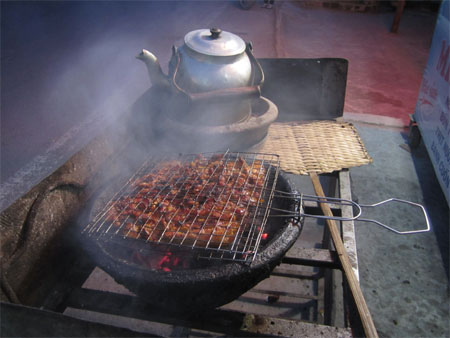Nem Cho Huyen (Cho Huyen pork roll) has a one-of-a-kind flavour that reflects the distinctive culinary culture of the central province of Binh Dinh. Ngoc Phuong reports.
 |
| Dinner for two: A set of nem dishes. |
Nem Cho Huyen (Cho Huyen pork roll) has a one-of-a-kind flavour that reflects the distinctive culinary culture of the central province of Binh Dinh. Ngoc Phuong reports.
Binh Dinh, a central coastal province with a stunning stretch of beaches and mountain ranges as well as beautiful islands, is a seriously underrated tourist destination.
Like many other Vietnamese regions, the province has its own special cuisine and traditions that should be better known.
Dishes that deserve to be included on the tourist culinary trail include banh xeo tom nhay (fresh savoury pancakes with shrimp), banh hoi chao long (thin rice vermicelli with rice porridge), banh it la gai (glutinous rice cake with white ramie leaves) and bun song than (dual-thread vermicelli).
But it is nem (pork roll) that is the real standout dish.
A snack that can be eaten as finger food or as an appetiser to a larger meal, nem appears everywhere in Binh Dinh, from vendors' baskets to luxury banquets.
There are two kinds of nem: nem tuoi (grilled fresh pork roll) and nem chua (fermented pork roll). The latter can be grilled or eaten fresh after removing the leaf covering.
Traditional nem contains either grilled or fermented pork in addition to crispy greens, peanut sauce, garlic, chili and aromatic herbs. It usually comes wrapped and rolled in rice paper.
The mixture of sweet, sour, salty and spicy flavours make your mouth salivate with each bite.
The province's speciality, Nem Cho Huyen, can be found in Tuy Phuoc's District's Phuoc Loc Commune.
The nem is named after Huyen market, which is located near a row of restaurants lining the 2km-long Highway 19 section that traverses the commune.
The restaurants' barbecue fill the street air with the aroma of grilled pork, whetting your appetite even hours before dinner time.
In the cool weather of the final days of winter, the warmth from the grills is especially welcoming.
Finding the restaurants, Vo Thi Thanh Hoa, deputy chief of the commune, however, told me that Bon Lai restaurant might be the oldest nem maker and showed me how to get there.
Upon arrival, I was pleasantly surprised to see that Bon Lai was small but airy.
Welcoming me was Nguyen thi An, 76, the owner.
"My father-in-law was the one who created nem Cho Huyen," she said. " I've been making nem since I was 17 when I married his son. Now my daughter-in-law is managing the restaurant."
 |
| Grilled to perfection: Nem tuoi (fresh pork nem) is grilled over charcoal. |
The grilled nem tuoi and nem chua I ordered were served with a special sauce of peanuts, chilli, fish sauce, sugar and other spices.
I also had a side dish with fresh cucumber, dill, basil, lettuce, garlic and green mango, accompanied by rice paper for rolling the vegetables.
Some people like to eat nem tuoi fresh off the grill, but I prefer to add vegetables and roll it in rice paper as it helps to reduce the fatty taste.
A bit of fiery chilli paste from the condiment basket also adds a nice bite to the nem.
The fermented nem was covered with a guava leaf, which I like to eat. But some people take it off as it has a slightly acrid taste.
Bau Da wine, another famous speciality of the province, is often served with nem.
Handmade delicacy
Producing nem is a complicated process requiring patient, skilled workers.
Cook Le Thi Bay of Bon Lai restaurant told me that she and her workers visit the slaughterhouse each day as early as 4am to buy the best quality pork.
Only pork from the thighs of six- to eight-month-old pigs can meet the quality requirement.
To make nem, the pork is first sliced and ground with sliced pigskin, sugar, salt and garlic. For nem tuoi, the mix will be grilled over charcoal.
Fermented nem is wrapped with a guava leaf to absorb the moisture, and then covered with a banana leaf to make it look more attractive.
After three or four days, when it has a slightly sour taste, it is ready to eat. As it keeps well, it can be offered as a gift to family, friends or co-workers.
Nem is also made in other regions, especially during the Tet(Lunar New Year) season, as it is considered one of the must-have foods during the holiday.
Although nem Cho Huyen has been famous for nearly 100 years, it has yet to have a trade name.
The commune authority in Binh Dinh Province, however, has registered a copyright for nem Cho Huyen as part of its master plan to meet criteria for the national government's new rural area programme, according to Hoa, the head of the commune's people's committee.
Though each region in the country has developed its own kind of nem, using most of the same ingredients, each version is a little different - crispier there, sweeter here and sour elsewhere. But all are indeed delicious. — VNS